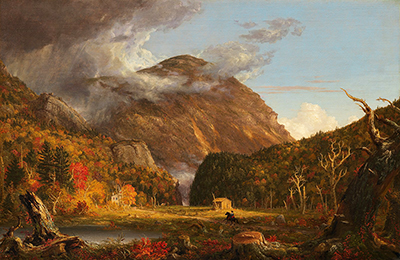A View of the Mountain Pass Called the Notch of the White Mountains is an oil on canvas creation by American painter, Thomas Cole. English-born Cole was fascinated by the way landscapes could hide or expose various meanings and symbolism.
The artist chose to paint this mountain pass, also known as Crawford Notch, due to its terrible and tragic associations with avalanche and death. The foreground is a frame of twisted trees and ruined stumps, which act as a dark omen for the danger deeper within the painting. The dead wood gives way to an open area of landscape; a picturesque valley and homestead with a lake and charming buildings. There is plenty of space here, and the illusion of seclusion for whomsoever might live here.
This stretches metaphysically to the illusion of safety, for although the valley might promise security, it is a false promise which the brooding mountain behind makes a lie of. The viewer's eye is irrevocably drawn to the misty pass between the hills. This is the path of danger, which a family travelled along to escape one alarming situation only to meet their doom courtesy of an avalanche. This was a true story, of the Willey family who lost their lives trying to move away from the site of a devastating landslide at Crawford Notch.
The single figure that rides along the autumnal valley seems oblivious to the danger, perhaps symbolising humankind's inherent disregard for the destructive potential of nature. The grey and leaden clouds swoop into the painting from the left, traditionally the direction of evil, and threaten to darken the beautiful, sunny day in the valley below. The message is clear; no matter how we may think we have mastered the wild, we can never be truly safe in a cruel and unpredictable world.
Cole painted his view on rough woven fabric, using a variety of painting techniques. There is a great deal of under-drawing, indicating the time and planning taken over this piece. For the sky, the paint was applied smoothly and in single layers. Moving further into the foreground, the brush work is deliberately less neat and looser, lending more texture and detail.
The painting itself was created in 1839, and now resides as part of a permanent collection at the Washington National Gallery of Art. Cole's landscapes inspired a whole new generation of painters. This became known as the Hudson River School. Cole loved to sketch out in nature, then take the drawings and paint over them. This mountainous examination of human tragedy is just one of his many attempts to capture the true majesty of the New York mountains he lived in.





